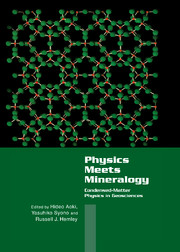Book contents
- Frontmatter
- Contents
- Preface
- List of Contributors
- Part I Introduction
- Part II Advances in Theoretical and Experimental Techniques
- Part III New Findings in Oxides and Silicates
- Chapter 3.1 Search for a Connection Among Bond Strength, Bond Length, and Electron-Density Distributions
- Chapter 3.2 MgO – The Simplest Oxide
- Chapter 3.3 First-Principles Theoretical Study of the High-Pressure Phases of MnO and FeO: Normal and Inverse NiAs Structures
- Chapter 3.4 Computer-Simulation Approach to the Thermoelastic, Transport, and Melting Properties of Lower-Mantle Phases
- Part IV Transformations in Silica
- Part V Novel Structures and Materials
- Part VI Melts and Crystal–Melt Interactions
- Subject Index
- Materials Formula Index
- Index of Contributors
Chapter 3.1 - Search for a Connection Among Bond Strength, Bond Length, and Electron-Density Distributions
Published online by Cambridge University Press: 05 November 2011
- Frontmatter
- Contents
- Preface
- List of Contributors
- Part I Introduction
- Part II Advances in Theoretical and Experimental Techniques
- Part III New Findings in Oxides and Silicates
- Chapter 3.1 Search for a Connection Among Bond Strength, Bond Length, and Electron-Density Distributions
- Chapter 3.2 MgO – The Simplest Oxide
- Chapter 3.3 First-Principles Theoretical Study of the High-Pressure Phases of MnO and FeO: Normal and Inverse NiAs Structures
- Chapter 3.4 Computer-Simulation Approach to the Thermoelastic, Transport, and Melting Properties of Lower-Mantle Phases
- Part IV Transformations in Silica
- Part V Novel Structures and Materials
- Part VI Melts and Crystal–Melt Interactions
- Subject Index
- Materials Formula Index
- Index of Contributors
Summary
The Pauling electrostatic bond strength s was originally defined as a measure of the average strength of the bonds comprising a coordinated polyhedron in a complex ionic crystal, but well-developed correlations between bond strength and bond length observed for oxide crystals convinced Brown and Shannon that it is not only a direct measure of the strength of a bond, but that it is also a measure of bond type: the greater the bond strength, the more covalent the bond. Bond critical point properties of electron-density distributions calculated for molecules and observed for crystals, show that the bond strength parameter p = s/r (r is the row number in the periodic table of the M cation) of an MO (oxygen) bond correlates with its bond length, the accumulation of the electron density at the bond critical point and the electronegativity of the M cation. Collectively, these trends lend support to the Brown and Shannon picture of bond strength as a measure of bond type.
Introduction
Only a handful of physical observables (bond length, force constant, dipole moment, polarizability) can be uniquely identified and associated with the individual bonds that bind atoms together into molecules and crystals. Over the years, each of these observables has played a pivotal role in advancing our understanding of the chemical bond. Of the four, bond length is not only the single most characteristic property of a bond, but also it is by far the most accessible and easy to measure.
- Type
- Chapter
- Information
- Physics Meets MineralogyCondensed Matter Physics in the Geosciences, pp. 83 - 94Publisher: Cambridge University PressPrint publication year: 2000



